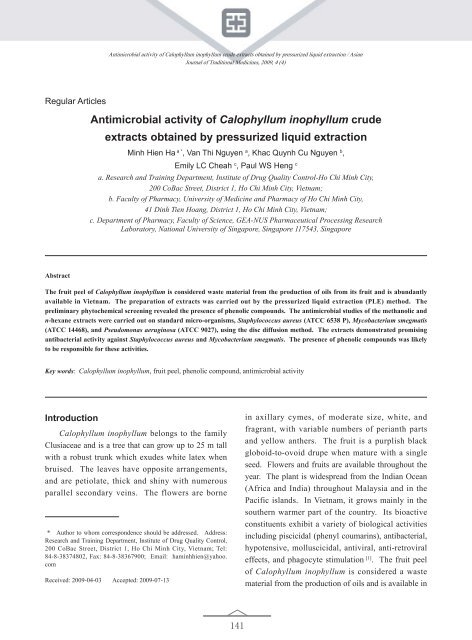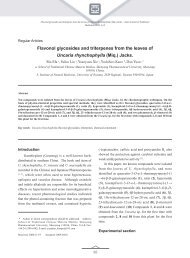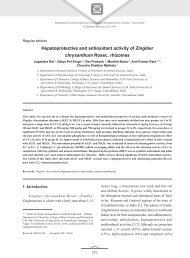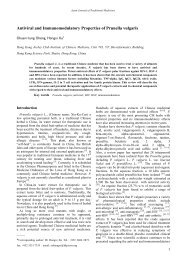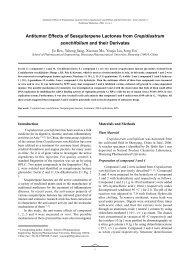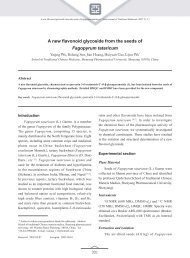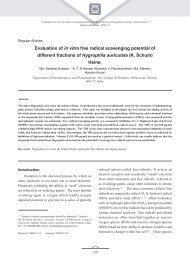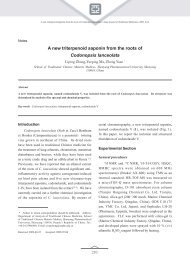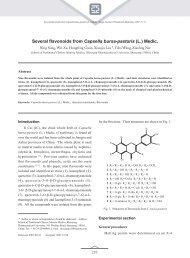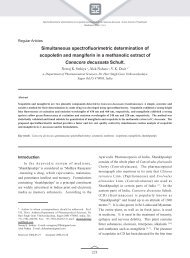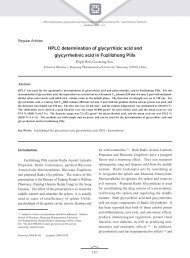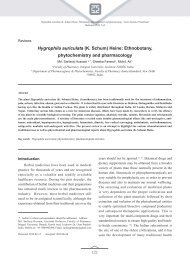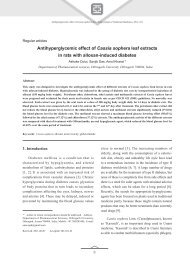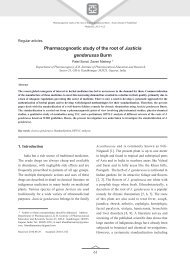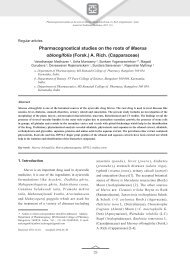Antimicrobial activity of Calophyllum inophyllum crude extracts ...
Antimicrobial activity of Calophyllum inophyllum crude extracts ...
Antimicrobial activity of Calophyllum inophyllum crude extracts ...
Create successful ePaper yourself
Turn your PDF publications into a flip-book with our unique Google optimized e-Paper software.
<strong>Antimicrobial</strong> <strong>activity</strong> <strong>of</strong> <strong>Calophyllum</strong> <strong>inophyllum</strong> <strong>crude</strong> <strong>extracts</strong> obtained by pressurized liquid extraction / AsianJournal <strong>of</strong> Traditional Medicines, 2009, 4 (4)Regular Articles<strong>Antimicrobial</strong> <strong>activity</strong> <strong>of</strong> <strong>Calophyllum</strong> <strong>inophyllum</strong> <strong>crude</strong><strong>extracts</strong> obtained by pressurized liquid extractionMinh Hien Ha a * , Van Thi Nguyen a , Khac Quynh Cu Nguyen b ,Emily LC Cheah c , Paul WS Heng ca. Research and Training Department, Institute <strong>of</strong> Drug Quality Control-Ho Chi Minh City,200 CoBac Street, District 1, Ho Chi Minh City, Vietnam;b. Faculty <strong>of</strong> Pharmacy, University <strong>of</strong> Medicine and Pharmacy <strong>of</strong> Ho Chi Minh City,41 Dinh Tien Hoang, District 1, Ho Chi Minh City, Vietnam;c. Department <strong>of</strong> Pharmacy, Faculty <strong>of</strong> Science, GEA-NUS Pharmaceutical Processing ResearchLaboratory, National University <strong>of</strong> Singapore, Singapore 117543, SingaporeAbstractThe fruit peel <strong>of</strong> <strong>Calophyllum</strong> <strong>inophyllum</strong> is considered waste material from the production <strong>of</strong> oils from its fruit and is abundantlyavailable in Vietnam. The preparation <strong>of</strong> <strong>extracts</strong> was carried out by the pressurized liquid extraction (PLE) method. Thepreliminary phytochemical screening revealed the presence <strong>of</strong> phenolic compounds. The antimicrobial studies <strong>of</strong> the methanolic andn-hexane <strong>extracts</strong> were carried out on standard micro-organisms, Staphylococcus aureus (ATCC 6538 P), Mycobacterium smegmatis(ATCC 14468), and Pseudomonas aeruginosa (ATCC 9027), using the disc diffusion method. The <strong>extracts</strong> demonstrated promisingantibacterial <strong>activity</strong> against Staphylococcus aureus and Mycobacterium smegmatis. The presence <strong>of</strong> phenolic compounds was likelyto be responsible for these activities.Key words: <strong>Calophyllum</strong> <strong>inophyllum</strong>, fruit peel, phenolic compound, antimicrobial <strong>activity</strong>Introduction<strong>Calophyllum</strong> <strong>inophyllum</strong> belongs to the familyClusiaceae and is a tree that can grow up to 25 m tallwith a robust trunk which exudes white latex whenbruised. The leaves have opposite arrangements,and are petiolate, thick and shiny with numerousparallel secondary veins. The flowers are borne* Author to whom correspondence should be addressed. Address:Research and Training Department, Institute <strong>of</strong> Drug Quality Control,200 CoBac Street, District 1, Ho Chi Minh City, Vietnam; Tel:84-8-38374802, Fax: 84-8-38367900; Email: haminhhien@yahoo.comReceived: 2009-04-03 Accepted: 2009-07-13in axillary cymes, <strong>of</strong> moderate size, white, andfragrant, with variable numbers <strong>of</strong> perianth partsand yellow anthers. The fruit is a purplish blackgloboid-to-ovoid drupe when mature with a singleseed. Flowers and fruits are available throughout theyear. The plant is widespread from the Indian Ocean(Africa and India) throughout Malaysia and in thePacific islands. In Vietnam, it grows mainly in thesouthern warmer part <strong>of</strong> the country. Its bioactiveconstituents exhibit a variety <strong>of</strong> biological activitiesincluding piscicidal (phenyl coumarins), antibacterial,hypotensive, molluscicidal, antiviral, anti-retroviraleffects, and phagocyte stimulation [1] . The fruit peel<strong>of</strong> <strong>Calophyllum</strong> <strong>inophyllum</strong> is considered a wastematerial from the production <strong>of</strong> oils and is available in141
<strong>Antimicrobial</strong> <strong>activity</strong> <strong>of</strong> <strong>Calophyllum</strong> <strong>inophyllum</strong> <strong>crude</strong> <strong>extracts</strong> obtained by pressurized liquid extraction / AsianJournal <strong>of</strong> Traditional Medicines, 2009, 4 (4)abundance in Vietnam.There is an explosion <strong>of</strong> interest in naturalantimicrobials from plant sources due to the rise <strong>of</strong>multidrug resistant strains <strong>of</strong> bacteria such as MRSA,VRE and multidrug resistant tuberculosis [2] . Thus,rapid screening techniques are essential to quicklyidentify and isolate these compounds. Conventionalsolvent extraction techniques have severaldisadvantages in terms <strong>of</strong> high volumes <strong>of</strong> organicsolvents consumed and long extraction times.Modern extraction techniques, such as pressurizedliquid extraction (PLE), seek to circumvent theselimitations. At the high pressures employed,extraction can be carried out above the boiling point<strong>of</strong> the solvent, which remains in the liquid phase,allowing better diffusion and improved mass transferkinetics [3] . This drastically reduces the amount <strong>of</strong>organic solvent used as well as the extraction time,from a period <strong>of</strong> hours to only minutes. PLE also<strong>of</strong>fers the possibility <strong>of</strong> performing extractions inan inert atmosphere protected from light, whichrepresents an advantage since phenolic compounds arevery sensitive to these two factors [4] .<strong>Calophyllum</strong> <strong>inophyllum</strong> fruit is used to extractoil. The oil has been proven to have vulnerary andcicatrising effects [5] . The fruit peel is <strong>of</strong>ten discardedas waste. To our knowledge, there is no studycurrently available on the antimicrobial properties<strong>of</strong> the <strong>Calophyllum</strong> <strong>inophyllum</strong> fruit peel. Thus,this paper describes a study aimed to establish (1)PLE as a rapid extraction method for obtainingbioactive principles from botanical material, and (2)to investigate the potential <strong>of</strong> <strong>Calophyllum</strong> <strong>inophyllum</strong>fruit peel as a source <strong>of</strong> antimicrobial compounds.Materials and methodsPlant materialsThe dried fruit peels <strong>of</strong> <strong>Calophyllum</strong> <strong>inophyllum</strong>were collected in December 2008 from Ben Treprovince which is situated about 80 km from Ho ChiMinh City, Vietnam.Pressurized liquid extractionThe plant material was pulverized using a Fitzmill (M5A, Fitzpatrick, USA) and sieved to obtaina powder with a median particle size <strong>of</strong> 1.84 mm [6] .Then, 5 g <strong>of</strong> the milled material was extracted byPLE (ASE-100, Dionex, USA) and the dead space inthe extraction vessel was minimized using 1-2 mmglass beads. Glass wool and 10 µm frits were placedat each end <strong>of</strong> the extraction vessel to prevent finescontaminating the extract. Extraction was carriedout at a fixed pressure <strong>of</strong> 1500 psi, a temperature <strong>of</strong>120 °C, and for a period <strong>of</strong> 15 min. A single cycle<strong>of</strong> extraction was used. Flush volume <strong>of</strong> 60 % anda nitrogen purge time <strong>of</strong> 90 s were used to rinse theequipment <strong>of</strong> any entrapped extract to enable a moreaccurate quantitative recovery.Soxhlet extractionSoxhlet extraction was conducted usingan automated Soxhlet extractor (B-811, Buchi,Switzerland). For this, 1 g milled material wasaccurately weighed and placed in a cellulose thimble(25 mm×27 mm×100 mm, Whatman, UK) andextraction was performed using methanol and n-hexanefor 8 h.Preparation <strong>of</strong> dried <strong>extracts</strong>The <strong>extracts</strong> obtained from both PLE and theSoxhlet extraction were dried under reduced pressureunder ambient conditions using a rotary evaporator(Eyela, Japan). The yield <strong>of</strong> extract, expressed as theweight ratio over the weight <strong>of</strong> raw material used, wascalculated. The <strong>extracts</strong> were stored in airtight vialsand kept refrigerated (2-8 °C) until further analysis.Screening <strong>of</strong> phenolic compoundsThin-layer chromatography was carried outusing thin-layer chromatography (TLC) plates <strong>of</strong> precoatedsilica-gel 60 F 254on aluminum sheets (Merck,Germany). Development <strong>of</strong> the TLC plates was142
<strong>Antimicrobial</strong> <strong>activity</strong> <strong>of</strong> <strong>Calophyllum</strong> <strong>inophyllum</strong> <strong>crude</strong> <strong>extracts</strong> obtained by pressurized liquid extraction / AsianJournal <strong>of</strong> Traditional Medicines, 2009, 4 (4)carried out vertically in a 20 cm×20 cm twin troughchromatographic tank, pre-saturated for 10 min(with filter paper) with an appropriate developingsolvent. The separation was allowed to run adistance <strong>of</strong> 100 mm from the lower edge <strong>of</strong> the plate.After developing, the plates were dried at ambienttemperature. Mobile phase systems used were: (A)n-hexane: ethyl acetate (7:3), (B) toluene: ethylacetate (8:2), and (C) chlor<strong>of</strong>orm: methanol (9:1).Detection <strong>of</strong> the compounds on the TLC plates wasmade under UV light at 254 and 366 nm and theywere subsequently sprayed with 5 % ferric chloridesolution.<strong>Antimicrobial</strong> assayStandard cultureStandard strains used were Staphylococcus aureus(ATCC 6538 P), Pseudomonas aeruginosa (ATCC9027), and Mycobacterium smegmatis (ATCC 14468)purchased in the form <strong>of</strong> inoculation loops from Oxoid(England). These micro-organisms were cultivated onnutrient agar until the 6 th generation and then used forthe study.Preparation <strong>of</strong> impregnated discsSterile paper discs (Whatman No.54) wereindividually impregnated with diluted plant <strong>extracts</strong>using the respective solvent (methanol or n-hexane) toobtain 100 μg <strong>of</strong> dried extract per disc. These discswere then dried at 40 ºC overnight before use.Then, 20 ml sterilized Mueller Hinton agar (3.8% w/v) was transferred to 90 mm Petri dishes andallowed solidify. Sterile water was used to wash thesurface <strong>of</strong> the colonies from fresh subcultures <strong>of</strong> thetest microorganisms. The turbidity <strong>of</strong> the microbialsuspension was standardized against McFarland tube0.5 (equivalent to 1.5×10 8 CFU/ml). The standardizedsuspension was diluted 10 times and 200 μl (3×10 6 CFU) was inoculated at the centre <strong>of</strong> the solidmedium. The suspension was evenly spread using aglass spreader on the surface <strong>of</strong> the agar and allowedto dry for 15 min. The extract-impregnated discsand a standard antibiotic disc (Table 1) were placedequidistant from each other on the surface <strong>of</strong> theinoculated agar and a period <strong>of</strong> 30 min was allowedfor diffusion <strong>of</strong> the compounds. The plates were thenincubated at 37 °C for 18 h (S. aureus, Ps. aeruginosa)and 48 h (M. smegmatis). The diameters <strong>of</strong> the zones<strong>of</strong> inhibition around the discs were measured to thenearest mm and recorded at the end <strong>of</strong> the incubationperiod. Two diameter readings, perpendicular to eachother, were recorded for each zone (d1 and d2), andthe average readings were calculated. The ratio <strong>of</strong> theaverage (dextract)/average (dstandard) was calculated foreach extract, and for each particular microorganism.Table 1. Microorganisms tested and the corresponding positivecontrolsMicroorganismStandard antibiotic discStaphylococcus aureus Methicillin 5 µgPseudomonas aeruginosa Carbenicillin 100 µgMycobacterium smegmatis Streptomycin 10 µgResultsExtraction method and yieldThe yields <strong>of</strong> respective <strong>extracts</strong> using methanoland n-hexane are shown in Table 2.Screening <strong>of</strong> phenolic compoundsExtracted compounds were separated by TLC andthe results are shown in Table 3. These spots produceda violet coloration with 5 % ferric chloride solutionindicating the presence <strong>of</strong> phenolic compounds.<strong>Antimicrobial</strong> <strong>activity</strong>The methanolic and n-hexane <strong>extracts</strong> weretested for their <strong>activity</strong> against Staphylococcusaureus, Mycobacterium smegmatis, and Pseudomonasaeruginosa and the results <strong>of</strong> their anti-microbialproperties are shown in Table 4.143
<strong>Antimicrobial</strong> <strong>activity</strong> <strong>of</strong> <strong>Calophyllum</strong> <strong>inophyllum</strong> <strong>crude</strong> <strong>extracts</strong> obtained by pressurized liquid extraction / AsianJournal <strong>of</strong> Traditional Medicines, 2009, 4 (4)Table 2. Extraction <strong>of</strong> <strong>Calophyllum</strong> <strong>inophyllum</strong> fruit peel with methanol or n-hexane by PLE and Soxhlet extractionNo.SolventCrude extract yield(% w/w)Crude extract mass(mg)1 st 2 nd Average Vial 1 Vial 2Extraction timeSolvent : feedratioExtract descriptionPressurized liquid extraction1 Methanol 10.19 9.78 9.98 510 490Dark brown sticky oil25-30 min 80:10:002 n-Hexane 1.12 0.79 0.96 57 40 Oily yellowSoxhlet extraction1 Methanol 3.91 4.18 4.05 80 86 8 h2 n-Hexane 0.9 0.99 0.95 18 20 6 h100:01:00Oily dark yellowYellow amorphoussolidTable 3. TLC-monitoring <strong>of</strong> methanolic and n-hexane <strong>crude</strong> extract <strong>of</strong> <strong>Calophyllum</strong> <strong>inophyllum</strong> fruit peel.No.CrudeextractMobile phaseA B CDetectionUV 254 UV 366 FeCl 35 % UV 254 UV 366 FeCl 35 % UV 254 UV 366 FeCl 35 %R fvalue1 Methanol 0.560.530.470.410.340.270.220.18-0.53-0.400.32-0.24--0.53-0.400.32-0.24-0.620.580.520.40--0.220.14-0.58-0.400.330.26-----0.400.330.26--0.850.700.640.470.410.350.300.200.850.700.640.470.410.350.300.20-0.700.640.470.410.350.300.200.110.060.130.050.130.05--0.180.050.180.05Number <strong>of</strong> spots 10 6 6 6 6 5 8 8 72 n-Hexane 0.790.530.470.390.320.260.200.130.790.650.470.39-0.24-0.130.790.650.470.39-0.24-0.130.82-0.590.48-0.280.220.150.820.640.590.440.350.26---0.640.590.440.350.26--0.850.780.700.640.510.470.350.300.850.780.700.640.510.470.350.30-0.780.700.640.510.470.350.300.070.03----Number <strong>of</strong> spots 10 6 6 6 6 5 8 8 7144
<strong>Antimicrobial</strong> <strong>activity</strong> <strong>of</strong> <strong>Calophyllum</strong> <strong>inophyllum</strong> <strong>crude</strong> <strong>extracts</strong> obtained by pressurized liquid extraction / AsianJournal <strong>of</strong> Traditional Medicines, 2009, 4 (4)Table 4. <strong>Antimicrobial</strong> <strong>activity</strong> <strong>of</strong> the <strong>Calophyllum</strong> <strong>inophyllum</strong> fruit peel methanolic and n-hexane <strong>extracts</strong> obtained by PLE (100 µg<strong>of</strong> the extract per loaded disc).Mean zone <strong>of</strong> inhibition (extract) / Mean zone <strong>of</strong> inhibition (stabdard) % (n = 2)Extraction solvent employedS. aureus Ps. aeruginosa M. smegmatisMethanol 58.1 Nil 46.9n-Hexane 53.8 Nil 37.5DiscussionThis results indicate that PLE can be employed toextract phenolic and antimicrobial compounds fromthe fruit peel <strong>of</strong> <strong>Calophyllum</strong> <strong>inophyllum</strong>. Whileextraction using n-hexane as the solvent resultedin similar extraction yield as Soxhlet extraction,methanolic PLE <strong>extracts</strong> resulted in a 2.5-foldgreater yield. n-hexane usually <strong>extracts</strong> lipophilicmaterial, such as plant waxes and essential oils,which normally account for a small fraction <strong>of</strong> thetotal dry weight <strong>of</strong> the plant. Methanolic <strong>extracts</strong>, onthe other hand, mainly extract moderately to highlypolar components, such as tannins, plant phenoliccompounds, as well as high molecular weightcompounds, such as sugars, starches, thus accountingfor their much higher yields [4] . Soxhlet extractionwas carried out at the boiling point <strong>of</strong> methanol whichwas 64.7 o C. The PLE extraction was carried out attemperatures above the boiling point as well as at anelevated pressure. In this instance, extraction yieldswould be increased for several reasons. (1) Thedielectric constant <strong>of</strong> methanol is reduced at elevatedtemperature and pressure resulting in lowering <strong>of</strong> thesolvent polarity. Hence, the spectrum <strong>of</strong> compoundsextracted by methanol in PLE would be markedlyenhanced compared with Soxhlet extraction. (2) Thehigh pressures employed in PLE allowed the solventto be driven into the matrix <strong>of</strong> the fruit peel. The-OH group <strong>of</strong> methanol would bind to polar matrixsites causing swelling <strong>of</strong> the plant matrix. Thisimproves accessibility to the solvent and improveddissolution <strong>of</strong> compounds in the extract. (3) The hightemperatures employed improve the mass transferrates as well as the desorption <strong>of</strong> compounds from thematrix [3] .The thin-layer chromatography results presentedin Table 3 indicate the presence <strong>of</strong> moderately tohighly polar phenolic compounds in the methanolicextract whereas less polar compounds were found inn-hexane extract.The <strong>crude</strong> <strong>extracts</strong> obtained by PLE demonstratedpromising antimicrobial activities against Staphylococcusaureus, and Mycobacterium smegmatis. The experimentswere performed with the corresponding positive controls,methicillin 5 µg and streptomycin 10 µg, respectively,and the ratio <strong>of</strong> the mean inhibition zones <strong>of</strong> thespecimen discs over the control discs was calculatedto compensate for the error due to the micro-organismdiffusion rate. The methanolic <strong>crude</strong> extract gave higherzones <strong>of</strong> inhibition in comparison with the n-hexane<strong>extracts</strong> indicating that the antimicrobial agents <strong>of</strong><strong>Calophyllum</strong> <strong>inophyllum</strong> consisted <strong>of</strong> moderately tohighly polar compounds. Earlier studies confirmed thatseveral phenolic constituents from the root bark and thenut <strong>of</strong> <strong>Calophyllum</strong> <strong>inophyllum</strong> exhibited antimicrobialactivities against Staphylococcus aureus [7] . Both polarand non-polar <strong>extracts</strong> demonstrated good <strong>activity</strong>against M. smegmatis and this result is promising asM. smegmatis is closely related to Mycobacteriumtuberculosis, which is the pathogen involved intuberculosis. It is likely that the n-hexane fractionalso possessed <strong>activity</strong> as lipophilic compounds aremore likely to permeate through the mycobacteriummembrane. None <strong>of</strong> the <strong>extracts</strong> inhibited Ps.aeruginosa, as this Gram-negative bacteria possess145
<strong>Antimicrobial</strong> <strong>activity</strong> <strong>of</strong> <strong>Calophyllum</strong> <strong>inophyllum</strong> <strong>crude</strong> <strong>extracts</strong> obtained by pressurized liquid extraction / AsianJournal <strong>of</strong> Traditional Medicines, 2009, 4 (4)an additional outer lipid membrane. It is likely thatthe antimicrobial compounds from the <strong>extracts</strong> wereunable to penetrate this membrane and no appreciableantimicrobial <strong>activity</strong> was obtained.ConclusionPLE methanolic and n-hexane <strong>extracts</strong> <strong>of</strong> discarded<strong>Calophyllum</strong> <strong>inophyllum</strong> fruit peel demonstratedpromising <strong>activity</strong> against Staphylococcus aureusand Mycobacterium smegmatis. This indicates thatthis material is a valuable source <strong>of</strong> antimicrobialcompounds. Modern extraction methodologies suchas PLE, having shorter extraction times, will preservethese antimicrobial compounds better than conventionalsolvent extraction techniques. Further investigationsare underway to compare the performance <strong>of</strong> PLEwith conventional extraction methods and to identifythe phenolic compounds which are responsible for theobserved antimicrobial <strong>activity</strong>.References[1] Medicinal plants in the south pacific, WHO regionalpublications, Western Pacific Series No.19, 1998, 29.[2] Drug Strategies in Antibacterials, Marcel Dekker, Inc.,2000, 115.[3] Waldeback M. Pressurized Fluid Extraction, PhD thesis-Uppsala Sweden, 2005, 25.[4] Buelga CS, Williamson G, Methods in PolyphenolAnalysis, UK, TheRoyal Society <strong>of</strong> Chemistry, 2003, 2,12.[5] Dweck AC, Meadows T. Tamaru (<strong>Calophyllum</strong><strong>inophyllum</strong>) - The African, Asian, Polynesian and PacificPanacea, Blackwell Science Ltd., 2002, 1.[6] US Pharmacopoeia 30, 2007, 318-20.[7] Yimdjo MC, Azebaze AG, Nkengfack AE, Meyer AM,Bodo B, Fomum ZT, <strong>Antimicrobial</strong> and cytotoxic agentsfrom <strong>Calophyllum</strong> <strong>inophyllum</strong>, Phytochemistry 2004, 65,2789-95.146


